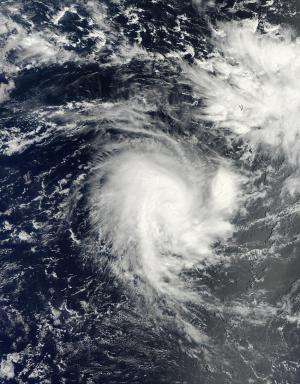NASA sees Tropical Cyclone Adjali develop a tail

When NASA's Terra satellite passed over the Southern Indian Ocean, the MODIS instrument aboard captured a picture of Tropical Cyclone Adjali that showed it developed a "tail," which is actually band of thunderstorms extending south of the center.
The Moderate Resolution Imaging Spectroradiometer, or MODIS instrument that flies aboard NASA's Terra satellite took a visible picture of Tropical Storm Adjali on Nov. 18 at 05:35 UTC (12:35 a.m. EST). The MODIS image showed a concentration of strong storms around the center of Adjali's circulation and a band of thunderstorms extending south of the center, resembling a "tail."
On Nov. 18, the Joint Typhoon Warning Center (JTWC) noted that bands of thunderstorms spiraling into the low-level center appeared to be weakening on microwave satellite imagery.
By 0900 UTC (4 a.m. EDT), Adjali's maximum sustained winds were near 60 knots (69/0 mph/111 kph). It was centered near 11.2 south latitude and 70.0 east longitude, about 279 nautical miles (321.1 miles/516.7 km) southwest of Diego Garcia. Diego Garcia is an island in the central Indian Ocean, and is part of the British Indian Ocean Territory.
Adjali had changed directions since Nov. 17 and was now moving to the southwest at 9 knots (10.3 mph/16.6 kph). Forecasters at JTWC now expect the storm to maintain intensity or slightly weaken over the next day. After that time, JTWC forecasters expect Adjali to weaken to a depression as it moves through cooler waters.
Provided by NASA's Goddard Space Flight Center



















